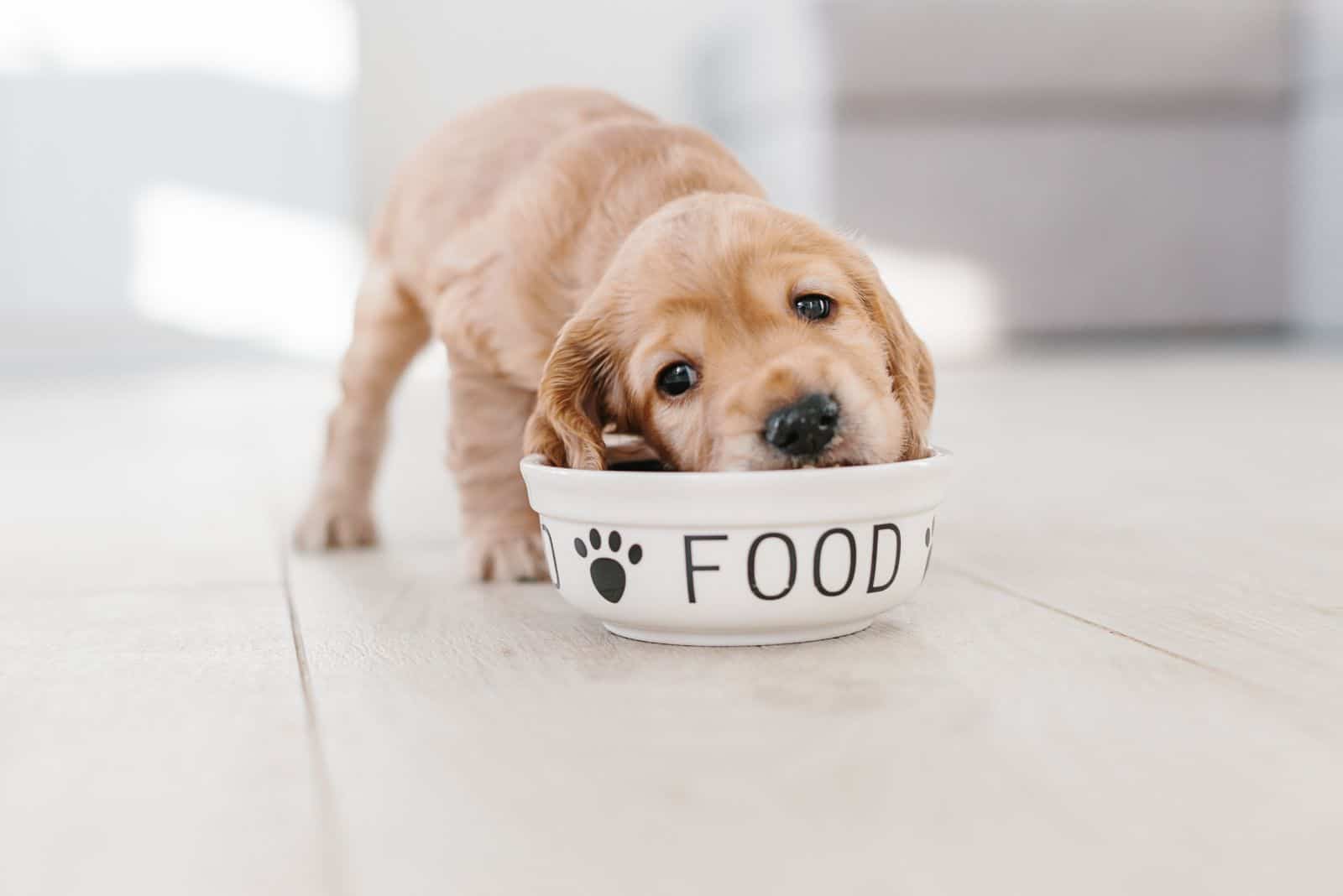Puppy feeding schedules can be a true nightmare for novice dog owners. How much should they eat? What should they eat? Do they eat enough? These endless questions can make you overwhelmed in no time.
However, there are some pretty useful tips that you can use in order to create the perfect feeding schedule.
But first, in order to understand how much to feed an 8-week-old puppy, you should take into consideration several things: dog age, breed, metabolism, energy and activity level, and weight. Each puppy has its own pace. However, there are some general tips related to all dog breeds that you can look into.
In this article, we will see how much puppies actually eat, what is their perfect feeding schedule, and what things you should pay attention to when feeding a puppy. Let’s begin!
How Much To Feed 8 Week Old Puppy
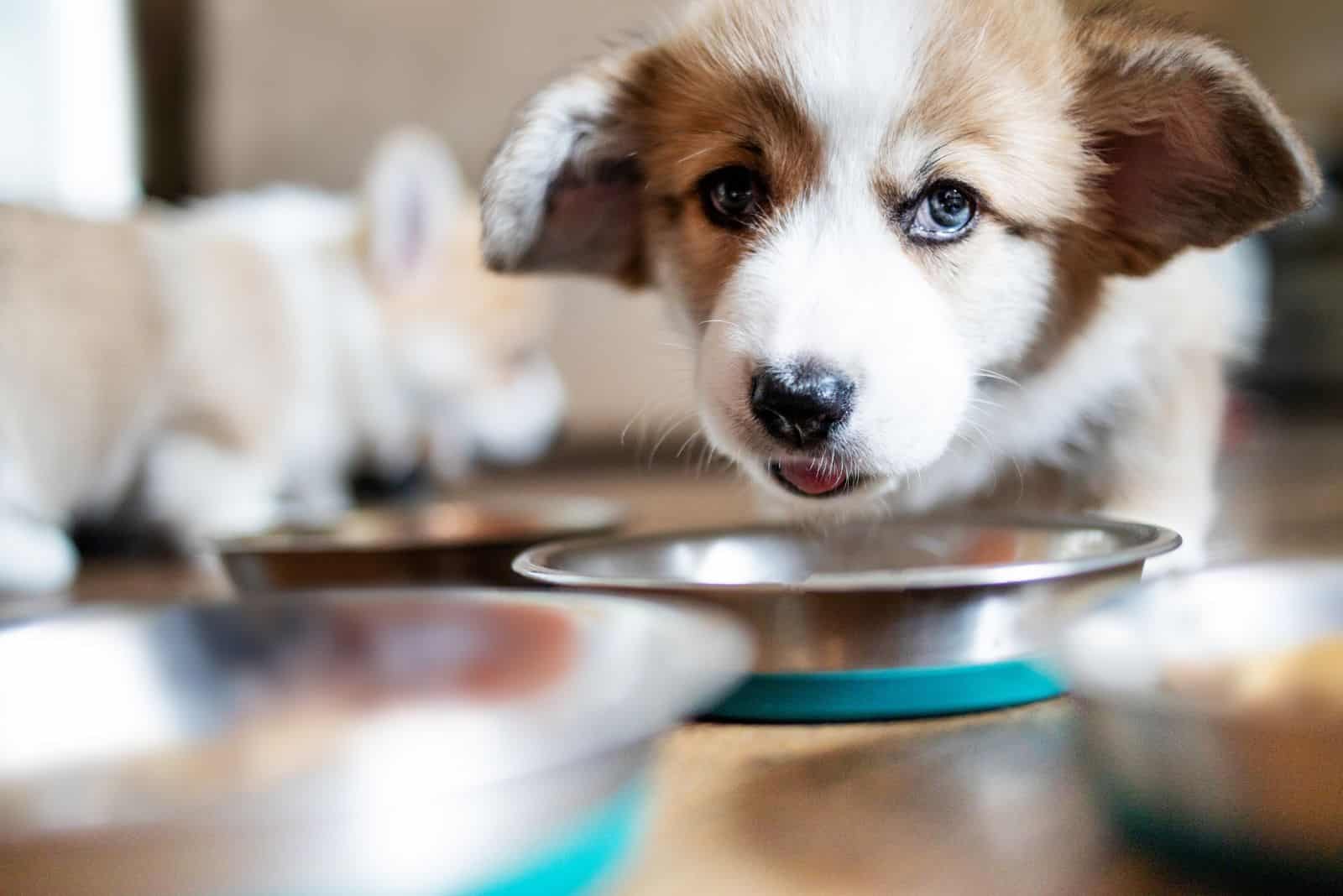
How much to feed a puppy is a constant dilemma for many dog owners. However, once you take into consideration determinants, such as dog breed, puppy’s energy level, age, and weight – things get easier.
In order to understand how much to feed an 8-week old-puppy, you need to understand that the puppyhood stage is probably the most sensitive age of all. It requires constant supervision and deep commitment.
During this period of time, transitional changes happen, such as the occurrence of the first puppy teething symptoms, the first puppy steps, and the opening of their eyes. However, puppies at eight weeks of age are old enough to transition from their mother’s milk to puppy food.
Generally, puppies at eight weeks of age, despite being a large, medium, or small breed, eat 1/2 cup three to four times a day.
This is the recommended amount of food each puppy should eat in order to maintain a healthy weight. Additionally, a puppy’s weight at this age should be monitored on a daily basis.
How Often Should An 8 Week Old Puppy Eat
Each dog owner has to have a well-prepared puppy schedule for their pets. Schedules will help you design a perfect daily routine for your puppy.
In that regard, you can create several independent schedules on feeding, sleeping, potty, exercising, and training.
When it comes to the feeding schedule, you should know that the ideal puppy feeding chart contains at least three to four meals a day. Puppies at eight weeks of age have just stopped drinking their mother’s milk. The process of adaptation to a new food is slow, and it takes time.
The advice is to always start with small portions. Furthermore, you should take care of your puppy’s nutritional needs. Proper amounts of protein, calcium, carbohydrates, and healthy fats are key to healthy growth.
Generally, puppies need a bigger protein intake, as it helps them develop muscles and get strong. Making a balance between wet and dry foods is probably a good idea, as some canines don’t respond well to monotonous diets.
Toy Breeds
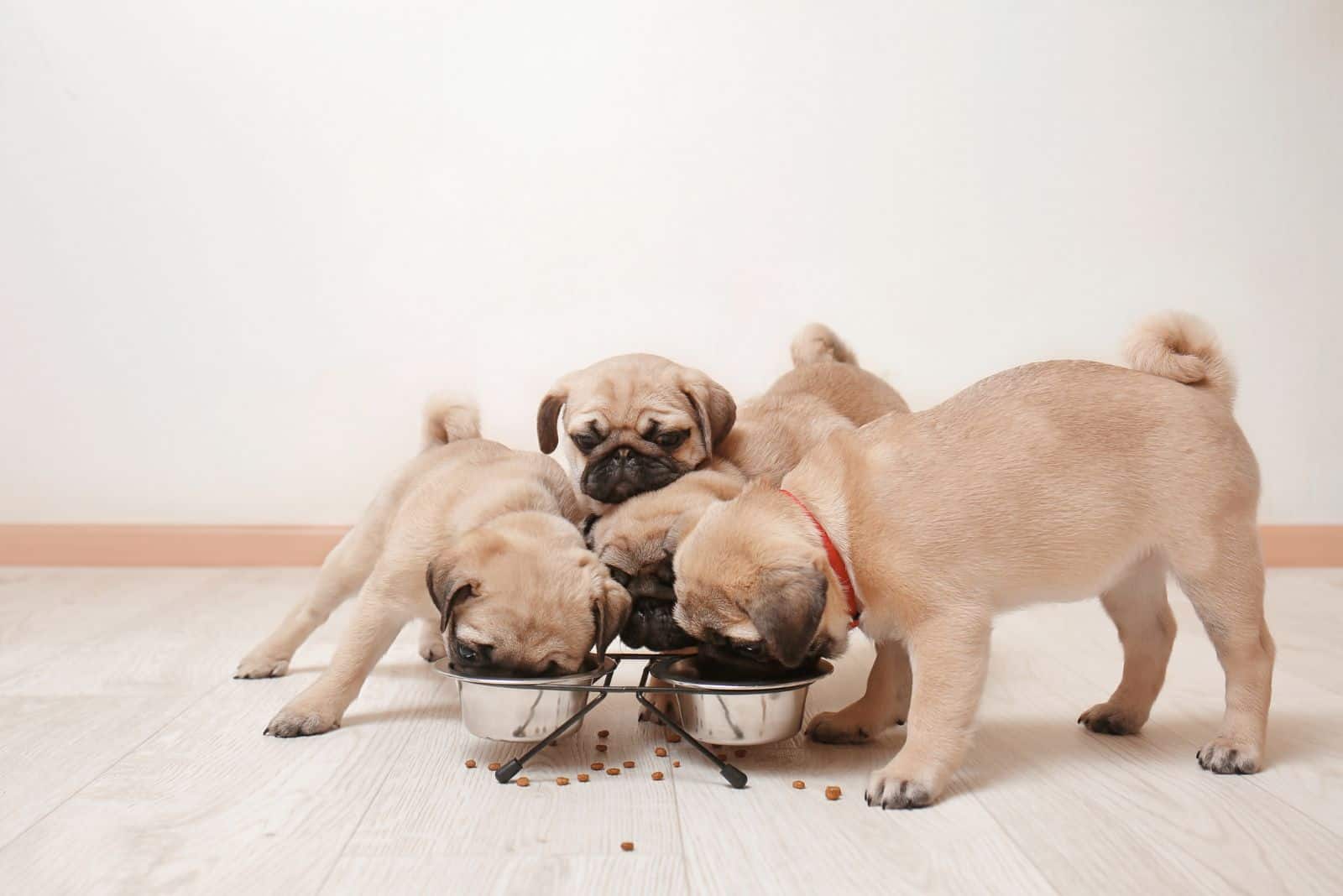
Toy breeds will generally need more meals a day, even when they become adult dogs. That’s because toy puppies cannot eat big portions of food at once, which is why giving them three meals a day is probably the best option.
However, regardless of their size, toy puppies, as well as all puppies, need at least three to four meals a day at the age of eight weeks. These are general puppy needs that help them grow healthy. However, the key to healthy growth is also giving a puppy a proper amount of food per meal.
Puppies that weigh up to 6 pounds usually need no more than 60g of food per day. On the other hand, puppies at 10 pounds of weight need around 100g of puppy food per day. Puppies above 20 pounds of weight need at least 200g of high-quality food.
If you have a dog breed with an underbite, such as a Pekingese, or a Maltese, you should probably be careful when giving dry kibble to your dog. Puppies with underbites have a sensitive jaw, and due to that, they require more suitable foods.
Small To Medium Breeds
There are some low-energy, medium-sized dogs that don’t require as much food as other medium-sized dogs, such as Basenjis or Whippets. Their food in adult age should be less caloric, as their energy requirements are not that high.
However, medium and small breed puppies at eight weeks of age need to have three to four high-quality meals during the day. Also, fresh water should always be available to your puppy. In order to predict the nutritional requirements of your dog, one of the solutions is to use a puppy calculator.
However, if you don’t have sufficient knowledge on how to properly raise a puppy, professional advice from a vet or dog trainer is probably the best option.
Small to medium breeds can eat wet, solid food, as well as dry dog food. However, you need to make a balance between these two, as some puppies don’t react the best to only one type of food. Dry food can cause urinary problems, as it doesn’t contain as much water as wet food.
During the first year, it is probably best to stick to a meal plan recommended by a breeder or a vet.
Large Breeds
Large breeds generally need more protein and bigger meals in order to meet their daily requirements. However, even the tallest dog breeds in the world can face obesity, so the best idea is to design a proper feeding chart for your puppy.
Puppies at eight weeks of age weighing around 10 pounds should eat at least 100g of pet food on a daily basis. On the other hand, puppies between 10 and 20 pounds of weight need a double amount.
Don’t ever forget the supplements when feeding a puppy at this age. Vitamins, minerals, as well as proper amounts of calcium, are essential for healthy growth. They add to the overall body condition score of your puppy, as well as to their overall health.
Large breed puppies need a proper feeding guideline in order to grow into muscular, athletic, and well-shaped dogs. However, unhealthy weight gain increases the possibility of facing many health issues, such as bloat or hip dysplasia.
Large dogs at two months old still need quality puppy nutrition, as adult dog food can have a negative impact on their digestive system. You should consult your vet to see what the best time is to start giving your puppy adult food.
What Foods 8 Week Old Puppies Can Eat
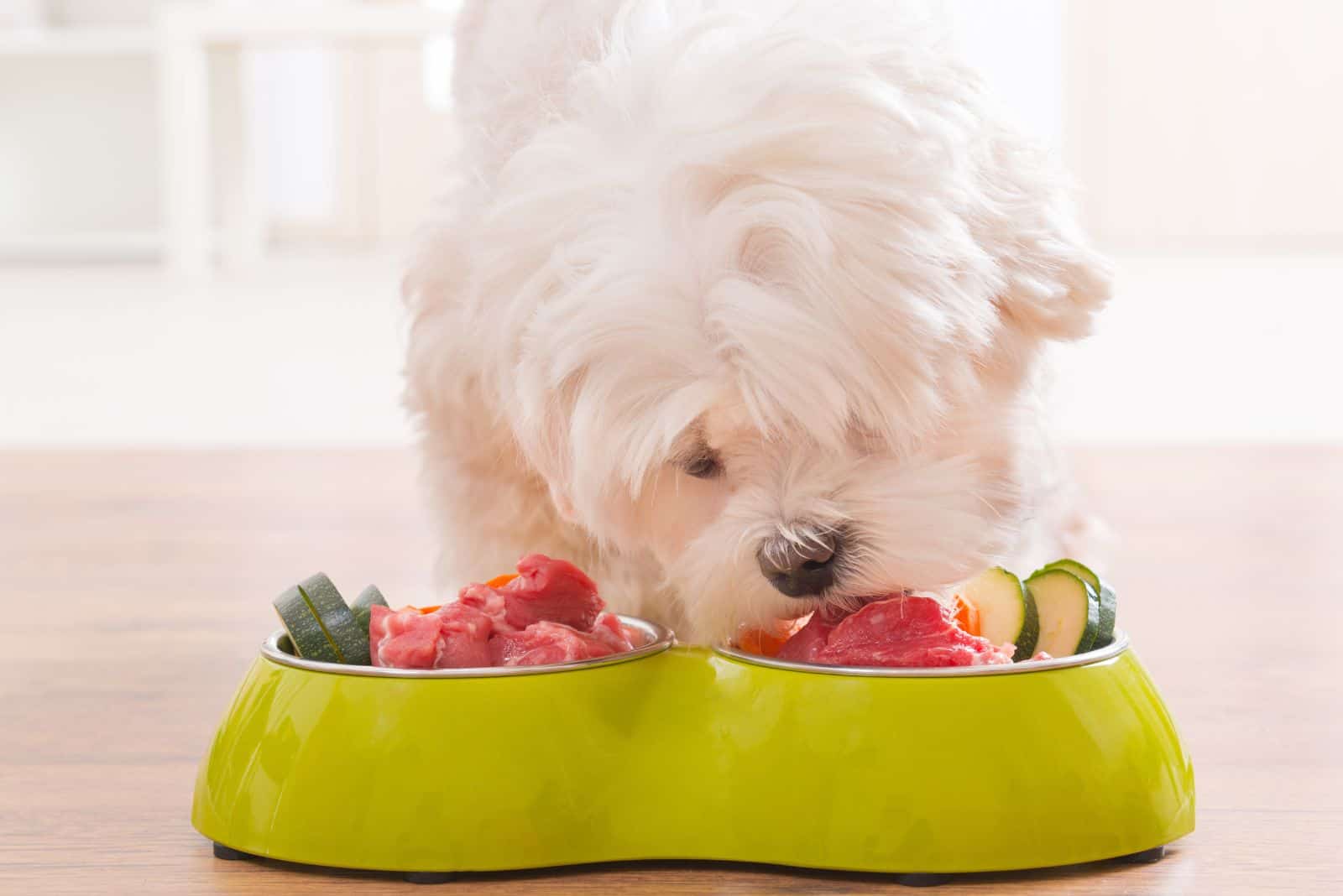
There are several types of food that you can give your eight-week-old puppy. Other than wet and dry food, one of the best options is homemade, raw food. However, always consult your vet about the ‘‘How much raw food to feed a puppy?’’ issue.
Purina wet puppy food is a good idea, especially because it contains high amounts of water. If you’re worried that your puppy doesn’t drink as much water as it should – be at ease. Wet food has sufficient amounts of water, too.
Still, getting a dog used to fresh water is an unavoidable part of its upbringing.
Wet food served with a milk replacer is a good solution for eight-week-old puppies. They are still in the process of adaptation, which means they need slow and well-prepared transition foods.
On the other hand, puppies that grow their first teeth can be served small portions of dry food. Dry food helps them develop a strong jaw bite and keeps their teeth healthy.
Vegetables and fruits in grains are generally good options, too. Weaning young puppies to various food options is not an easy process, as it takes time. Once you get your new puppy used to proper nutrition and a well-established puppy’s diet, the whole process gets easier.
How Long Until You Start Giving Puppies Adult Food
Each puppy has a different path when it comes to feeding. However, a general timeframe for the implementation of adult food starts at six months of age. Puppies between six and twelve months of age are old enough to start eating smaller meals of adult food.
However, the transition to adult food doesn’t necessarily mean stepping back from the proper puppy feeding guide. Juvenile puppies still need foods enriched with DHA, calcium, vitamins, and minerals.
Having the best food prepared for a dog is a lifetime commitment. You should always be adapting the food to a puppy’s dietary needs. Avoiding table scraps, junk food, and unhealthy snacks is a lifetime struggle.
On the other hand, non-prescription dog food for urinary health, as well as foods that are easy on the stomach, are always a good idea.
Things To Avoid
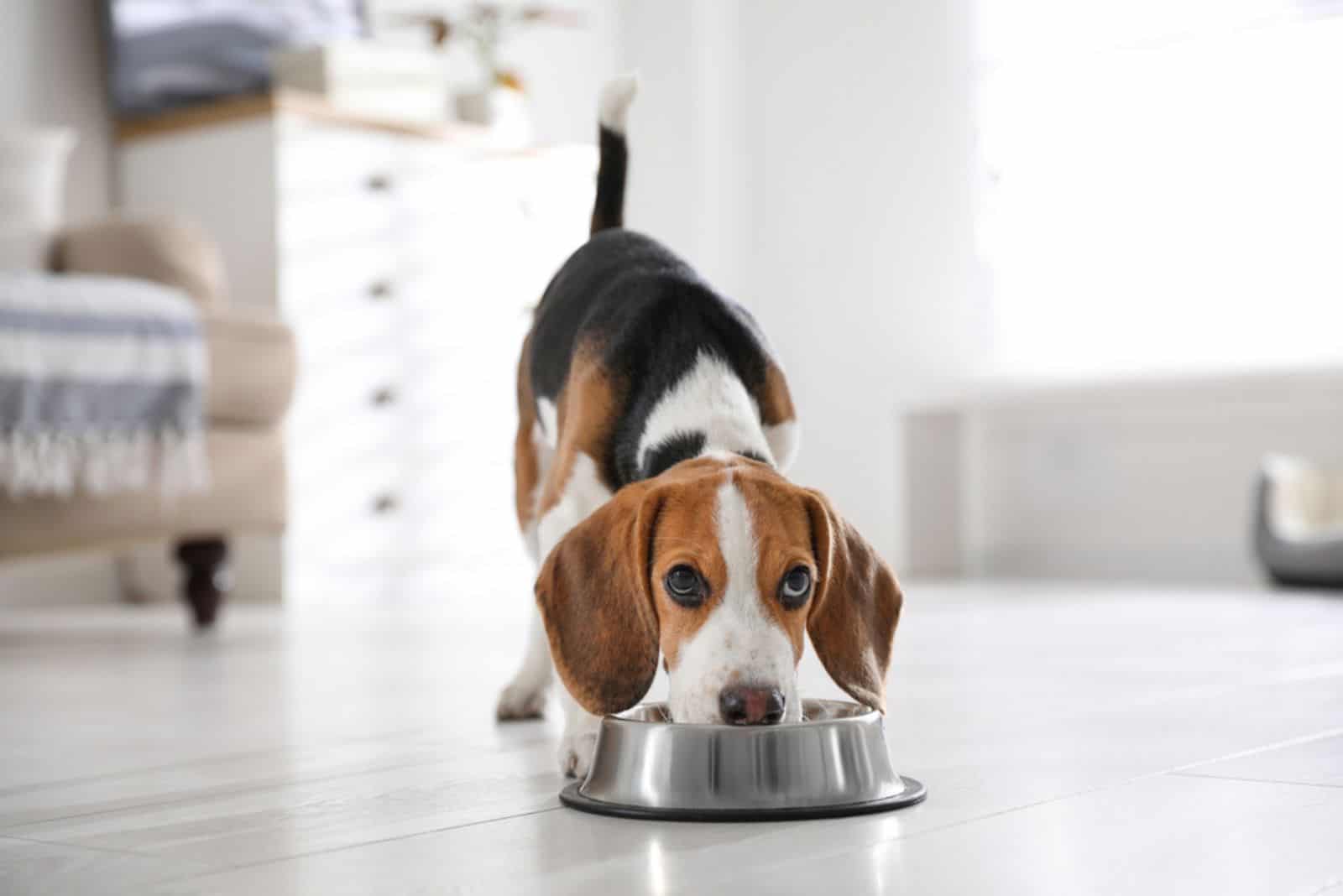
There are several things to avoid when it comes to puppy feeding. Even the healthiest dog breeds in the world require a healthy feeding chart. That means avoiding junk food, overfeeding, underfeeding, and unhealthy dog snacks.
1. Junk Food
Junk food is never a good option. You should avoid table scraps at all times, as well as the worst dog food brands on the market. Junk food can lead to bloat, obesity, and several other health conditions, such as diabetes, cataracts, hip dysplasia, and cardiac diseases.
Large dogs in particular, can deal with severe bloating, which sometimes can be a result of eating junk food voraciously.
Bloating can have deadly repercussions, especially if not treated timely. Obesity is another problem caused by junk food. This condition doesn’t necessarily represent a disease, but it creates further problems.
For instance, obesity leads to lethargy, lack of activity, weak bones, and possibly, aggression. Obese dogs that have a high-energy level by default can suffer from severe anxiety, too.
You should adapt your new pet to healthy food from the start. Using positive reinforcement techniques is one of the best ways to start implementing healthy snacks and healthy foods. The more you postpone this process, the harder it gets in the future.
2. Overfeeding
Overfeeding is another problem first-time dog owners can face. That’s why a consultation with your vet about the best possible puppy feeding chart is probably the smartest idea.
Overfeeding can cause puppy diarrhea at night, obesity, bloat, hiccups, heart disease, and a reduced lifespan. Overfeeding especially affects small dog breeds. Puppies such as Chihuahuas, Pekingeses, and Malteses need to have a strict feeding chart.
Excessive weight gain affects their overall bone structure. In the long run, overweight puppies will be unable to perform their regular activities, such as running, jumping, or even walking.
The best way to monitor your puppy’s weight is if you design a puppy growth chart from the early puppyhood stage. That way, you can monitor your puppy’s growth properly and see how different foods and eating habits affect your puppy in the long run.
3. Underfeeding
On the other hand, underfeeding is also a major problem. The question of ‘‘How long does it take for a dog to gain weight’’ can be a long-term dilemma for dog owners who don’t take enough care of their puppies’ nutrition.
Some symptoms of underfeeding are excessive shedding, fur loss, excessive weight loss, lack of energy, lethargy, bad vision, poor breath, reduced metabolism, a poor immune system, and the occurrence of various dog diseases.
Underfed puppies usually don’t have normal growth, which causes many problems in the latter stage of their lives. Insufficiently built muscles or a poor immune system can cause further injuries and diseases in the long run.
Never skip a meal, and always try to stay on track with your puppy’s feeding chart.
4. Too Many Dog Snacks
A useful tip to all dog owners is to use interactive dog toys as the primary positive reinforcement tool instead of giving your puppy big amounts of dog snacks. Healthy dog snacks are recommended in between meals.
However, you should always take care of how much you actually give them. Large dogs can probably have more daily snacks, as they are more active and they burn their calories easily.
On the other hand, small dog breeds need a strict feeding chart, with only a few snacks during the day.
Unhealthy snacks can be a major problem in the long run, as they cause obesity and they affect the feeding chart negatively.
There is a pretty good chance that your dog might refuse their daily meals if they’ve already had too many snacks. This can be a major problem, as snacks usually don’t contain as many healthy nutrients as regular dog foods.
How Much Water Should A Puppy Drink
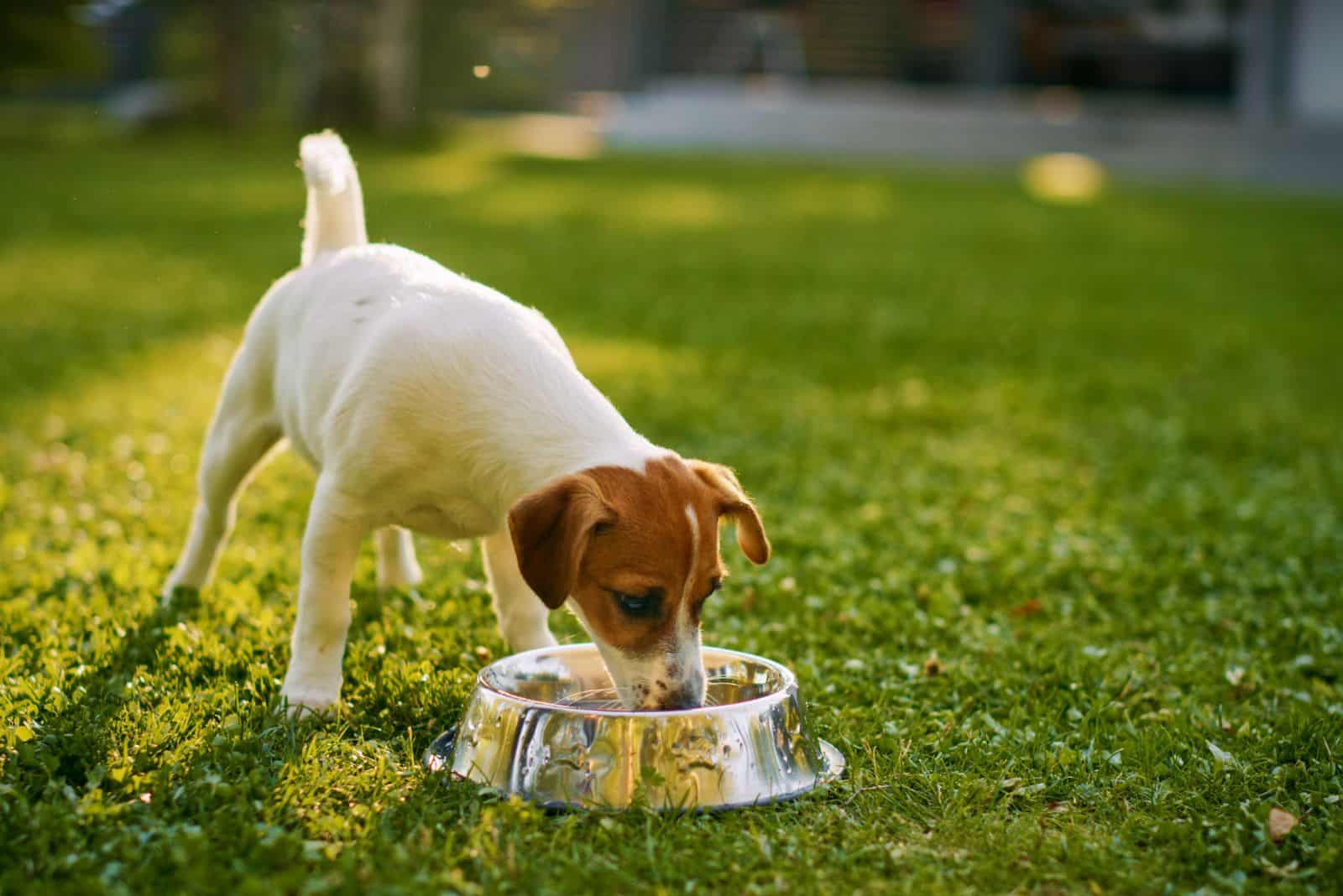
Fresh water should be available to puppies at all times. If you’re preoccupied with how much to feed an 8-week-old puppy, you should probably know that drinking water is as equally important as feeding.
Water is essential for every puppy’s age. However, if you notice that your puppy doesn’t drink as much water as it should, you should consult your vet. In some cases, giving a puppy wet food is a good replacement for insufficient water drinking.
The general water intake of puppies at eight weeks of age is one ounce per pound of body weight.
Getting puppies used to drinking water should be a regular part of their early training. If a dog coughs after drinking water – be at ease. It can be a simple gagging reflex that protects their lungs.
FAQs
1. What Is A Good Feeding Schedule For An 8 Week Old Puppy?
Generally, a good feeding schedule for an eight-week-old puppy represents three to four meals on a daily basis.
Excessive or insufficient food can cause a disbalance in your puppy’s daily schedule. Overfeeding or underfeeding can cause a plethora of undesired symptoms, such as obesity, weight gain or weight loss, lethargy, lack of activity, heart disease, bloat, hip dysplasia, and many others.
If you’re wondering why your dog cries at night – it could be due to an imbalanced feeding chart. Underfed puppies can have a bad sleeping time, as well as overfed puppies.
2. What Should I Feed My 8 Week Old Puppy?
You will need a good dog food review in order to find the most suitable food for your puppy. However, there are some general food tips that you can use in order to feed your puppy properly.
For instance, a combination of wet and dry food is always a good idea. Furthermore, the homemade raw food diet is acceptable as long as you stick to dietary requirements.
Always choose foods that contain the proper representation of protein, carbohydrates, and healthy fats. Bear in mind that dogs at eight weeks of age will probably need more protein than adult dogs.
Also, calcium, as well as DHA, is needed for neural development, as well as for skeletal health.
Final Thoughts
‘‘How much to feed an 8-week-old puppy’’ is a constant dilemma for all dog owners. In order to figure out the best possible way of feeding your puppy, you will need a well-planned puppy feeding chart.
However, there are some other general things that you need to take into consideration in order to fulfill your puppy’s dietary needs, such as a feeding schedule, regular water drinking, slow adaptation to new foods, your dog’s age, metabolism, and breed.
Hopefully, this article has given you some useful tips for the future!
